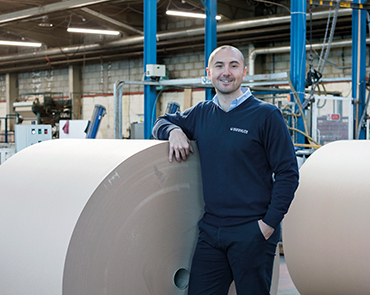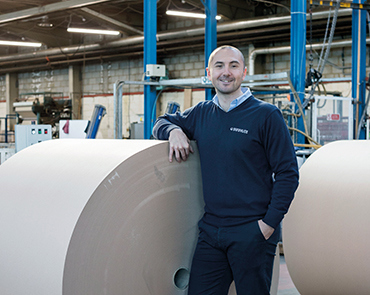Here’s a long-established British manufacturer that offers sustainable, renewable paper-based products that replace plastics for signage, packaging and construction work. Dufaylite Developments is at the leading edge of today’s eco-zeitgeist with durable and printable sheet materials made from sustainable paper boards materials with honeycomb centres for strength and lightness.
It supplies materials for exhibition stands, graphic displays, packaging products and ground movement solutions. They’re stiffer and stronger than corrugated papers, boards and even some metals and plastics.
However, the origins of Dufaylite, and its name, date back to Second World War aircraft development. In the 1940s radar was very new and aircraft manufacturers were trying to fit it to fighters and submarine hunters.
One problem was that radar reflects off metal, which is great if you’re hunting Heinkels, but hard to put into your own metal aircraft, as the radio waves just bounce around inside. Aircraft makers wanted to protect their aerials behind streamlined structures called radomes, so they needed a non-metallic material transparent to radio waves.
The solution was Perspex acrylic plastic made by ICI, but one ingenious inventor proposed a strong, lightweight and easily obtained alternative made from a thin plywood sandwich, strengthened with a paper honeycomb filling.
The inventor was George May, who worked with a company called Dufay-Chromex. He called his lightweight material Dufaylite, which was unselfish of him otherwise this story might be about a company called Maylite. Although rejected for radar, his honeycomb panels were later adopted for lightweight panels inside aircraft.
Dufay-Chromex itself was originally created in 1937 as a joint venture between Ilford and a film maker called Spicer-Dufay to sell an early colour film called DufayColor, a process first invented in 1909 by a Frenchman called Louis Dufay. Spicer-Dufay was a 1920s spin-off from Spicers Ltd, owner of a couple of paper mills – film in those days was made from cellulose, as is paper.
All interesting stuff, but actually today’s Dufaylite company is only indirectly connected to Dufay-Chromex. The link is George May. In the 1950s investors from several trading companies teamed up to establish a new company to make materials for the post-war boom in prefabricated houses, using easily obtainable wood and paper raw materials in those days of rationing. They recruited May as technical director and the new company was named after his patented honeycomb material, Dufaylite.
Markets and products
In the 1960s the most common usage of honeycomb was in domestic flush doors. Over the years Dufaylite boards were developed for other applications using paper board instead of wood. There are three main product lines today. Ultra Board is used for print, signage and exhibitions/displays, as an alternative to wood or MDF. Premier Paper is exclusive distributor in the UK. Dufaylite’s managing director Ashley Moscrop says: “It can replicate what wood does, with the same beam strength and compression and is fully recyclable. Applications include pallet tops or shelving, beds, desks etc, as well as sign and display panels. Ultra Board is created from up to 87% recovered fibres, so it’s already had at least one life before even reaching the printers and designers. It is recycled again at the end of use – the possibilities, and process are quite literally endless.
“95% of our customers print directly onto our substrate using flatbed inkjet printers.” This is significantly quicker and easier than laminating a printed layer on top, he says. Ultra Board is mostly cut to shape on CAD tables, though slitters can be used for straight cuts.
Envirolite is a shaped packaging solution that Dufaylite says is unique. Shapes can be cut and slotted together to make load-bearing protective structures which are recyclable after use. “It is ideal as a replacement for polystyrene, foam and corrugated materials,” Moscrop says. “Using our lightweight, versatile boards we offer a wide range of products from simple edge protection, void fillers or layer pads through to bespoke systems to solve complex packaging and shipping problems.” Dufaylite offers this as a complete service and handles all the cutting and despatch in-house.
Clayboard continues Dufaylite’s tradition in the construction industry. It’s used as a ‘ground movement solution,’ under floors, giving a sustainable construction void former which gives virtually no uplift if the ground swells when wet. Clayboard is about 30% lighter than other void formers, so needs fewer deliveries, less steel reinforcement and generates far less waste earth that has to be taken away.
Manufacturing facilities
Dufaylite was originally located in Borehamwood, before moving to St Neots in 1965. It also owned a panel factory in Queenbrough, Isle of Sheppey, from the early 1970s to late 1980s.
The St Neots factory occupies 7,000sqm, filled with specialist machinery where all production and manufacture of the honeycomb board takes place. The paper is bought in from mills and converted into honeycomb, which is then turned into boards and used to create end-solutions for customers.
“The factory is split into two halves,” explains Moscrop. “The first is focused on the processing and production of honeycomb and Ultra Board, taking raw paper and turning it into our core product. The second is dedicated to conversion into our packaging product Envirolite. We convert boards into specific packaging requirements for our customers, so we cut, shape and dispatch them. It is also used as our warehouse.”
All the production machinery is purpose built and specially sourced. Over the years the production processes have been refined, says Moscrop. “In the beginning the honeycomb was made via three processes. It began as blocks, which were cut into sheets then stuck together to form the honeycomb, which took time. Now we have a special machine that does this all and is considerably quicker. With regards to manufacturing boards, the process is essentially the same, but advancements mean production is now five times faster.”
Dufaylite currently employs 37 people. Ashley Moscrop is the second generation of his family to run it. His father Tony was head-hunted in 1995 when Dufaylite was experiencing a difficult trading period. After rebuilding and restructuring it he completed a management buyout in 2000 with two other directors. He still has a “strategic and forward-looking role” and participates in industry associations to share his experience.


Ashley Moscrop originally joined aged 18, initially learning to work with the company’s first CAD cutting tables. Dufaylite invested in a small printer to help drive an understanding of Ultra Board applications so Moscrop completed a graphic design course to understand artwork files and pre-print.
Following this he gained a marketing qualification and in 2007 moved into sales and marketing with Green Graphics, a print service set up by Dufaylite to supply printed solutions to demonstrate Ultra Board’s applications and versatility in the retail and display sector. By 2014 Green Graphics was felt to have done its job and was closed. Moscrop became group sales and marketing director until 2018 when he was promoted to managing director. He has since restructured the team and developed the current business strategy.
“We grew during the pandemic and added some new products,” he says. These included standup displays and signage to organise social distancing. “Due to Covid we saw a 64% increase in Envirolite packaging sales, and we added new machinery to increase our capacity by 35%.” However, the core product Ultra Board took a hit. “We saw a huge drop in sales overnight after an initial rush following the first lockdown which saw retailers rushing to replace signage. We saw a slow progression to rebuild this, but sales have now reached normal levels again. We export Ultra Board, which currently makes up 15% of our sales, but we have plans to reopen channels across the world.”
There have been further challenges this year, he says. “Reflecting on Brexit, we have been affected by the recent driver shortages, making deliveries harder. Deliveries from overseas have remained the same with little impact. Paper prices have risen by 65% and there are longer lead times due to increased demand and restricted supply.”
What’s next?
“We are seeing changes in all three markets,” says Moscrop. “More products and solutions are being replaced with environmentally friendly alternatives. We’ve especially seen huge changes in the food delivery sector, and have developed a thermal packaging insert for in-box deliveries with a leading provider.”
New services and products are about to be launched, he says. “We are set to launch our new Design Lab this coming autumn/winter, which will deliver bespoke design solutions in person for customers. We will also be launching a new website which will hold downloadable cutting files, enabling people to use our product to produce creative applications themselves.
“We are also introducing Ultra Board 2D and 2D white to the range. These are intended to replace Foamex or foamboard and Dispa for high volume daily signage use, a different market to our traditional Ultra Board which is mostly sourced for campaigns.”
STAR PRODUCTS
“In graphics and display it would be our 3D and 3D white product,” says Moscrop. “It can be used to create any number of weird and wonderful products from elephants to desks! For packaging our in-box protection is our current best seller but our thermal box liner for the food delivery market is rapidly growing.”











